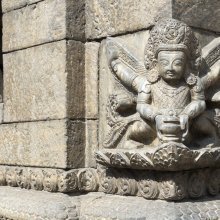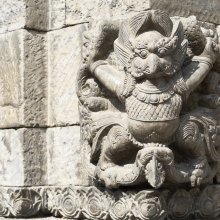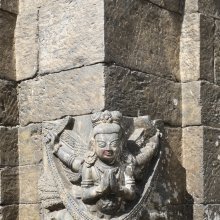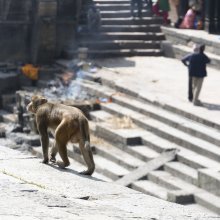Temple building: 2 definitions
Introduction:
Temple building means something in Hinduism, Sanskrit. If you want to know the exact meaning, history, etymology or English translation of this term then check out the descriptions on this page. Add your comment or reference to a book if you want to contribute to this summary article.
Images (photo gallery)
In Hinduism
Vastushastra (architecture)
Source: Shodhganga: Elements of Art and Architecture in the Trtiyakhanda of the Visnudharmottarapurana (vastu)Temple building is a sacred work and is necessary especially in the age of Kali (i.e., kaliyuga), who represents irreligiousness, according to Puranic lore such as the Viṣṇudharmottarapurāṇa, an ancient Sanskrit text which (being encyclopedic in nature) deals with a variety of cultural topics such as arts, architecture, music, grammar and astronomy.—According to the Viṣṇudharmottarapurāṇa, temple building is regarded as a sacred work. The Bṛhatsaṃhitā also agrees on it and says that-one, who wishes to attain desirable things in this world, should construct a temple. [...] In the Bhāgavatapurāṇa, it is said that after Dvāparayuga, on the very day when lord Kṛṣṇa left the earth, Kali, who is the source of irreligiousness had entered in this world. Thus, people of Kaliyuga have lost their power to communicate with God directly through prayers and chanting mantras. And that is why, specially in the Kali-yuga, the necessity of the temple building is suggested in the Viṣṇudharmottarapurāṇa.

Vastushastra (वास्तुशास्त्र, vāstuśāstra) refers to the ancient Indian science (shastra) of architecture (vastu), dealing with topics such architecture, sculpture, town-building, fort building and various other constructions. Vastu also deals with the philosophy of the architectural relation with the cosmic universe.
Pancaratra (worship of Nārāyaṇa)
Source: Shodhganga: Kasyapa Samhita—Text on Visha Chikitsa (p)Temple Building is denoted by the Sanskrit term Mandira-Nirmāṇa and represents one of the principal topics of the Pāñcarātra division of the Vaiṣṇava Āgamas.—The almighty Hari, out of compassion for mankind in general, felt that the Vedas and Śāstras could not be easily grasped and practised by people belonging the diverse communities and cadres, whose potential and comprehension would vary vastly. Hence, he promulgated the Pāñcarātra doctrine [teaching for example temple building—mandira-nirmāṇa] which is the essence of the Vedas, in a simplified form.

Pancaratra (पाञ्चरात्र, pāñcarātra) represents a tradition of Hinduism where Narayana is revered and worshipped. Closeley related to Vaishnavism, the Pancaratra literature includes various Agamas and tantras incorporating many Vaishnava philosophies.
See also (Relevant definitions)
Partial matches: Building, Temple.
Full-text (+39): Historical diversity, Cultural diversity, National diversity, Geographical diversity, Climatic diversity, Ethnic diversity, Galimamtapa, Tirupani, Vimana, Way of life, Temple architecture, Mandiranirmana, Temple, Mandapa, Shaivagama, Aditya, Halsi, Parantaka, Halshi, Kirtana.
Relevant text
Search found 36 books and stories containing Temple building; (plurals include: Temple buildings). You can also click to the full overview containing English textual excerpts. Below are direct links for the most relevant articles:
Samarangana-sutradhara (Summary) (by D. N. Shukla)
Vishnudharmottara Purana (Art and Architecture) (by Bhagyashree Sarma)
2. Necessity of Temple Building < [Chapter 4 - Temple Building]
1. Origin and Development of Temple building < [Chapter 4 - Temple Building]
Temples in and around Madurantakam (by B. Mekala)
Imperialistic Rule < [Chapter 2 - Temples: Role and Influence]
Political History (6): The Pallavas < [Chapter 1 - Historical Backdrop]
Early Chola Temples (by S. R. Balasubrahmanyam)
End of an Epoch < [Chapter XIV - Conclusion]
*Temples of the age of Uttama Chola* < [Chapter X - Historical Survey]
The Cholas < [Chapter XIII - Prasada: Component Parts]
Later Chola Temples (by S. R. Balasubrahmanyam)
Temples in Tiruvanaikka < [Chapter XVIII - Chola-Hoysala Phase]
Temples in Alangudi < [Chapter XIV - Temples of Rajaraja III’s Time]
Vastu-shastra (5): Temple Architecture (by D. N. Shukla)
Chapter 7 - Planning of Prāsāda—The Hindu Temple
Chapter 4 - Prāsāda styles (F): Lāṭa
Temples of Orissa (3): Koṇārka < [Chapter 12 - History of Hindu Temples (Prāsādas and Vimānas)]




